Shine Bright on the Greens: How to Clean Golf Clubs
- Last updated on December 1, 2023
- Toni Benedito
- Golf Equipment & Gear, Blog
Clean golf clubs are essential for optimal performance and longevity. Regular cleaning prevents dirt and grass buildup, enhancing spin, trajectory, and accuracy. Use warm, soapy water for irons and a soft brush for metal woods. Maintain clean club grooves for better ball control. Don’t forget the importance of cleaning shafts and grips. Proper storage, organization, and avoiding extreme conditions contribute to overall club care. Invest time in maintenance for an enjoyable and extended golf club lifespan.

Key Takeaways
- Maintaining your golf clubs through regular cleaning is crucial for optimal performance, enhancing factors like spin, accuracy, and overall longevity on the course.
- Differentiating cleaning techniques based on club types—metal woods, irons, and grips—ensures effective maintenance without risking damage to these essential golf components.
- The impact of proper storage cannot be overstated. Storing clubs in a climate-controlled environment, steering clear of extreme temperatures, safeguarding against warping, discoloration, and rust, and preserving their condition for the long run.
- Paying attention to shaft and grip care is key. Neglecting to clean shafts may affect grip and swing, while regular grip cleaning not only improves control but also contributes to consistent performance and accuracy.
- Beyond functionality, a well-maintained golf club collection adds to the overall enjoyment of the game. It not only extends the life of your equipment but also reflects a genuine respect for the sport and consideration for fellow players on the course.
Introduction
Golf is a game of elegance, finesse, and power. As golfers, we invest time and money in our clubs to help us improve our game and make those sweet shots down the fairway.
However, many golfers neglect one essential aspect of their equipment: clean club maintenance. Why You Should Clean Your Golf Clubs
Cleaning your golf clubs should not be seen as an optional task; it should be an integral part of your routine after every round. The reasons for cleaning your clubs are plenty: maintaining their performance, preventing rust buildup on the club heads and shafts, improving grip traction and longevity, and avoiding bacteria buildup on grips that can cause health issues such as warts or athlete’s foot.
What You Need to Clean Golf Clubs To start cleaning your golf clubs properly, you need a few basic tools: a bucket filled with warm water and mild dish soap or specialized golf club cleaner solution; soft-bristled brushes for cleaning grooves on the club heads; clean towels to dry off the clubs after cleaning; cotton swabs to get into hard-to-reach areas like hosels.
Furthermore, organizing golf clubs before cleaning them will also help you keep track of what needs attention. Sort out your collection by club type (wooden vs. iron), then by individual club number.
This way, you can easily check if any club is missing or needs repair after each round. Maintaining Golf Clubs on the Course
Enjoying this article? Read more:
Check out this video below from Golf Monthly‘s YouTube channel on how to clean your golf clubs:
While it’s essential to clean your golf clubs after every round, maintaining them during play is just as crucial to keeping them in tip-top shape.
Here are some tips for tee maintenance: Use rubber tees instead of wooden ones that can damage driver faces over time; use divot repair tools when needed to help maintain the golf course; and use a clean towel or brush to wipe off mud and dirt before hitting shots.
Storing and Caring for Your Golf Clubs Storing your golf clubs properly is also essential to their longevity.
Do not leave them in direct sunlight or at extreme temperatures. Instead, store them in a bag with the headcovers on, preferably in an area that’s not too humid or damp.
By following these tips for club maintenance, you’ll be able to upgrade your game and keep your golf clubs looking like new. In the next section, we’ll dive into specific cleaning techniques for each part of your golf club: the head, shaft, grip, and more.
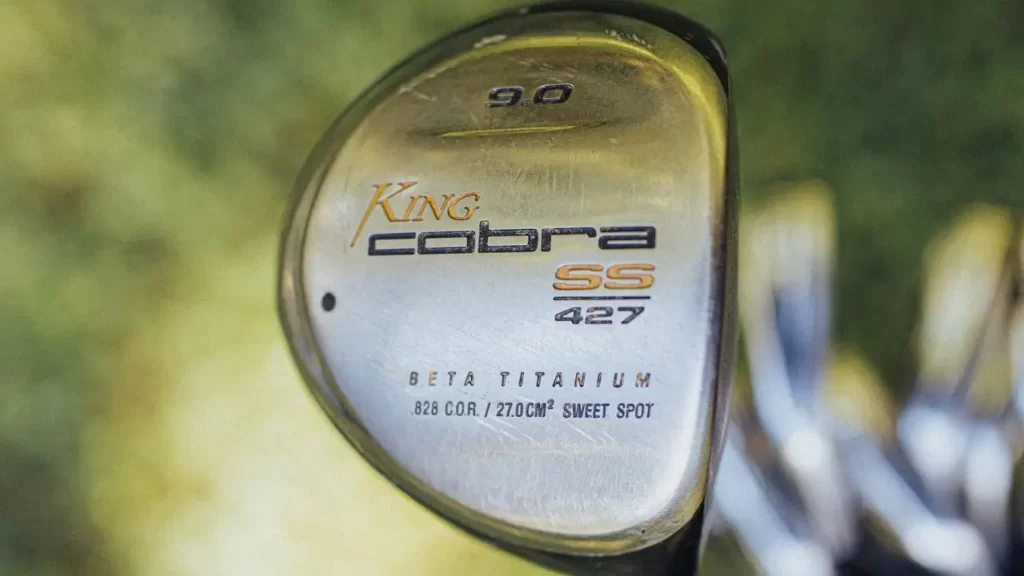
Why You Should Clean Your Golf Clubs
Embarking on a round of golf is not just about swinging clubs; it’s a commitment to respect for the game and your fellow players. An often underestimated aspect of this commitment is the regular cleaning of your golf clubs. Beyond the initial perception of tedium, this practice is a cornerstone of responsible golfing, yielding tangible benefits that enhance both performance and the overall enjoyment of the game.
Here are some reasons why you should clean your golf clubs:
- Performance Enhancement: Clean golf clubs are synonymous with better performance. Residues like dirt and grass on your clubface can adversely affect ball spin and trajectory, directly impacting shot accuracy.
- Ball Control: Clean clubheads contribute to greater ball control, facilitating more consistent shots. Regular maintenance and cleaning are fundamental to extending the lifespan of your valuable golf equipment.
- Rust Prevention for Irons: Regular cleaning prevents rust on irons, preserving the clubface and functionality. The delicate nature of wood clubs further emphasizes the importance of gentle handling during cleaning.
- Enjoyable Golf Experience: Beyond performance gains and longevity, clean clubs elevate the entire golfing experience. The unpleasant scenario of reaching for a dirty club with stained grips or grooves filled with dirt is avoided, ensuring an uninterrupted focus on playing your best game.
- Respectful Golfing: Cleaning your golf clubs is a gesture of respect for the game and fellow players. It’s an essential aspect of responsible golfing that transcends the tangible benefits, creating an environment conducive to a more enjoyable and respectful round.
As someone who has navigated the golf course landscape in the role of a caddie, I can attest to the frustration that arises when handling dirty or poorly maintained equipment. The commitment to regular cleaning and maintenance isn’t just about personal performance; it’s a responsibility to the sport and those sharing the course with you.
By integrating this practice into your routine, you not only elevate your game but also contribute to a golfing community where every player, armed with well-maintained clubs, can focus on the pure joy of the game. It’s more than a routine; it’s an essential golf accessory that every responsible player must include in their kit.
Enjoying this article? Read more:
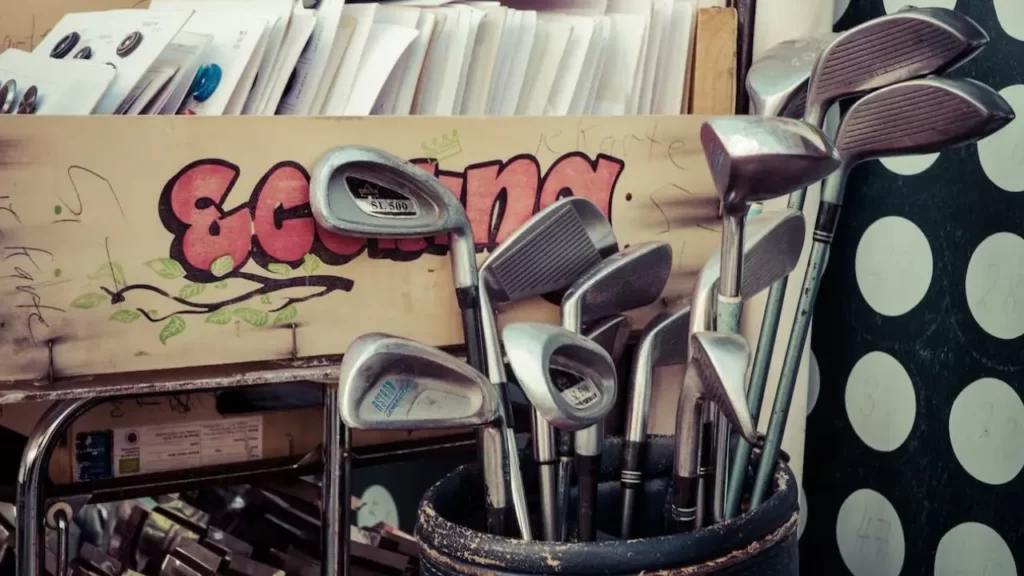
What You Need to Clean Golf Clubs
Embarking on a successful round of golf extends beyond perfect swings; it hinges on the meticulous care of your golf clubs. As these essential tools endure the demands of the course, regular cleaning becomes a cornerstone, ensuring their longevity and peak performance.
In this guide, we delve into the critical components of maintaining your golf clubs, offering insights into the tools and practices necessary for optimal care. From the initial considerations of choosing the right cleaning solution to the nuanced differentiation in cleaning practices for irons, woods, and putters, each detail plays a pivotal role.
Here are some pointers to what you need to clean your golf clubs:
- Essential Tools for Cleaning: To clean your golf clubs effectively, start with a bucket or container large enough for water immersion. This serves as the initial step in preserving their quality.
- Choosing the Right Cleaning Solution: Opt for a cleaning solution that won’t compromise the club’s finish or performance. Warm water with mild dish soap or a specialized golf club cleaner is recommended to avoid damage.
- Avoid Harsh Chemicals: Steer clear of harsh chemicals, as they can strip away the protective coating, leading to rust and other damages. Preservation is key for prolonged club functionality.
- Proper Drying Techniques: Use towels or cloths for thorough drying post-cleaning. Avoid abrasive materials like steel wool or harsh brushes to prevent scratches that may mar the appearance of your clubs.
- Differentiation in Cleaning: Understand the unique needs of irons, which accumulate debris in their grooves, requiring more attention. Woods and putters, being delicate, necessitate gentler care due to materials like graphite for wood and iron construction.
- Grip Maintenance: Regular grip maintenance is essential for a secure hold on the club, preventing negative impacts on swing mechanics during play. Specialized grip maintenance products are available for occasional use.
- Necessary Tools and Practices: Golfers must be equipped with all necessary tools, from correct storage practices to extra towels on rainy days. Understanding how different cleaners affect various clubs and even considering a golf bag assistant all contribute to maintaining clubs in top-notch condition.
In the realm of golf, the journey to excellence encompasses more than skillful swings—it’s a commitment to the comprehensive care of your clubs. Remember, from the choice of cleaning solutions to the meticulous differentiation in cleaning practices, every detail matters. As you embark on this journey, armed with essential tools and knowledge, you’re well on your way to ensuring your clubs remain in peak condition, ready for the challenges that every round on the golf course presents.

How to Clean Golf Club Heads
Cleaning the golf club heads is an essential part of club maintenance. Neglecting this aspect can significantly affect golf club performance. The cleaning process varies depending on the material of the club head, so you should take care to clean each type properly.
Here’s how to clean golf club heads:
Metal Woods
Metal woods, or fairway woods and drivers, are popular among golfers because of their durability and power. To clean metal woods, use a soft-bristled brush or toothbrush to remove any dirt or grass stains from the grooves and face of the club head. Be gentle when brushing to avoid scratching the finish on your clubs. Afterward, dip a cloth in warm water and wring it out thoroughly before wiping down the entire head.
Iron Clubs
Iron clubs are designed for accuracy rather than distance, like metal woods but require more attention when it comes to cleaning. To clean irons, first soak them in warm, soapy water for 10–15 minutes to loosen up any dirt buildup around grooves and edges. Next, use a stiff-bristled brush or toothbrush to scrub away any remaining dirt on the face and grooves of each iron.
Cleaning Club Grooves
Clean club grooves are essential for good ball control on course greens. Rusty or dirty grooves can have an adverse effect on ball spin, resulting in inadequate distance control while striking shots with different lofts (e.g., pitching wedge). Use a groove cleaner tool or a fine wire brush specifically designed for this purpose; however, you’ll need enough pressure. Again, be careful not to scratch the metal surfaces of your clubs.
Rust Spot Removal
Rust spots can occur over time if metal clubs aren’t cleaned promptly after getting wet during playtime,, especially during early morning rounds with dew still present on grasses around tees, greens, etc., or if left in storage longer than recommended periods without proper protection against moisture-related problems such as humidity or excessive exposure to heat.
To remove rust spots, you’ll need some rust remover or white vinegar mixed with baking soda and a bristle brush. Dip the brush into the solution and apply it to the affected area carefully. After some time has passed, rinse well with warm water.
Cleaning golf club heads is crucial for maintaining their performance, increasing their lifespan, and ultimately improving your game on the course. Knowing how to clean each type of clubhead is essential so that you don’t damage them during cleaning.
By following these steps regularly, along with caring for golf clubs by storing them correctly after each use and keeping them in good condition, you can ensure they serve you well for years to come.
Enjoying this article? Read more:
Check out this video below from ROUGH GOLF‘s YouTube channel on how to clean golf clubs:
How to Clean Golf Club Shafts
When it comes to cleaning your golf clubs, don’t forget about the shafts. Neglecting to clean your club shafts can lead to a build-up of dirt and grime that could potentially harm your grip or even affect your swing. But the good news is that cleaning them is a pretty straightforward process.
The first step in cleaning your club shafts is to gather all of the necessary tools. You’ll need a bucket of warm water, some mild dish soap, and a soft cloth or sponge.
If you’re dealing with particularly stubborn dirt or stains, you may also want to invest in some specialized club cleaning tools like wire brushes or rust spot removal solutions. Once you have everything you need, start by dipping your cloth or sponge into the warm, soapy water and wringing out any excess liquid.
Gently wipe down each club shaft, paying particular attention to any areas with visible dirt or grime. You may need to use more elbow grease for tougher spots, but avoid using too much force, as this could damage the finish on your clubs.
If you’re dealing with wooden clubs, be careful not to get them too wet, as this can cause warping or other damage over time. Instead, use a damp cloth and focus on gently removing any dirt or debris without saturating the wood.
After wiping down each shaft thoroughly, rinse off any excess soap with clean water and dry off each club completely before storing them back in your golf bag. By taking care of your club shafts as part of your regular club care routine, you can ensure they stay in top shape for many rounds of golf to come.
When it comes down to it, maintaining wooden clubs requires different techniques compared to maintaining the newer composite iron clubs used today in professional settings. So whether you’re getting paid minimum wage as a caddie assistant at one of the nation’s best courses, like Pebble Beach, or working in one of the new-age golf simulators, make sure you follow these tips for club cleaning and ensure your grip is secure every time you take a swing.
Enjoying this article? Read more:
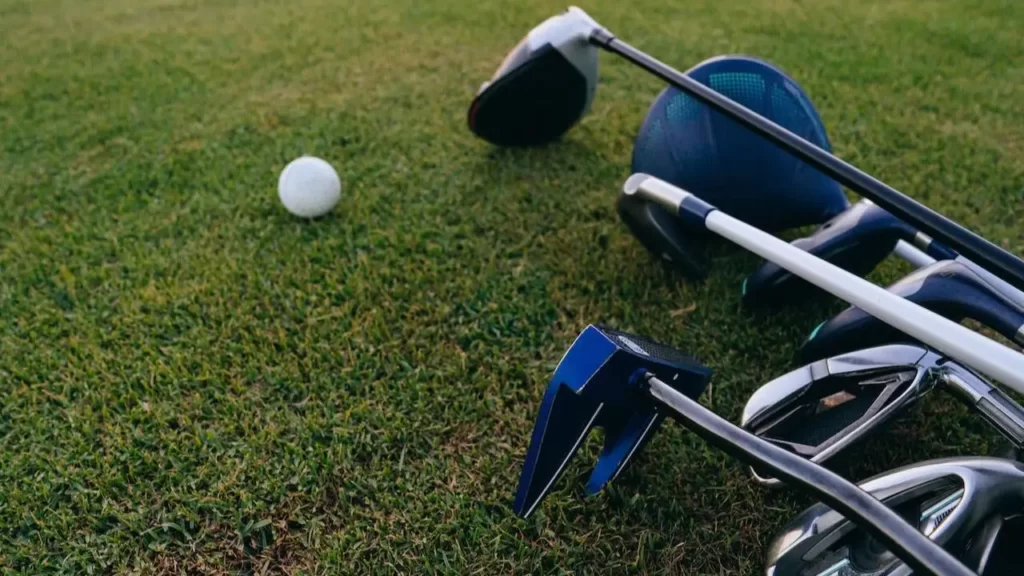
How to Clean Golf Club Grips
When it comes to golf club grips, a lot of players might overlook their importance. However, dirty and worn-out grips can significantly impact your performance on the course. A good grip allows you to have better control over the club, which ultimately leads to better shots. Therefore, taking care of your golf club handles should be an essential part of your care routine.
The first step in cleaning your golf club grips is to remove them from the clubs. This will allow you to give them a thorough cleaning and make sure that no dirt or grime is left behind. To do this, use a screwdriver or other appropriate tool to loosen the grip’s adhesive tape and slide it off the shaft.
Once you have removed the grip from the club, you need to prepare for cleaning by getting all necessary materials, such as lukewarm water, mild soap or detergent, a soft-bristled brush, and a towel. Fill a large basin with lukewarm water, and add a small amount of mild soap or detergent.
Dip the brush into this solution and gently scrub away any dirt or grime that has accumulated on your club handles. After scrubbing each handle down thoroughly with soapy water, rinse them under warm running water until no suds are visible anymore.
Dry each handle with a clean towel and let them air-dry for several minutes before reinstalling them onto your clubs. Although cleaning golf grips may seem like an extra chore for some golfers who would rather be out playing on the course than maintaining their gear at home,
However, by taking proper care of your clubs’ handles regularly, you’ll be investing in better performance during every game as well as extending their lifespan. Don’t neglect to care for golf club grips if you want to improve your game consistently while keeping up with good hygiene habits and on-the-course etiquette simultaneously!
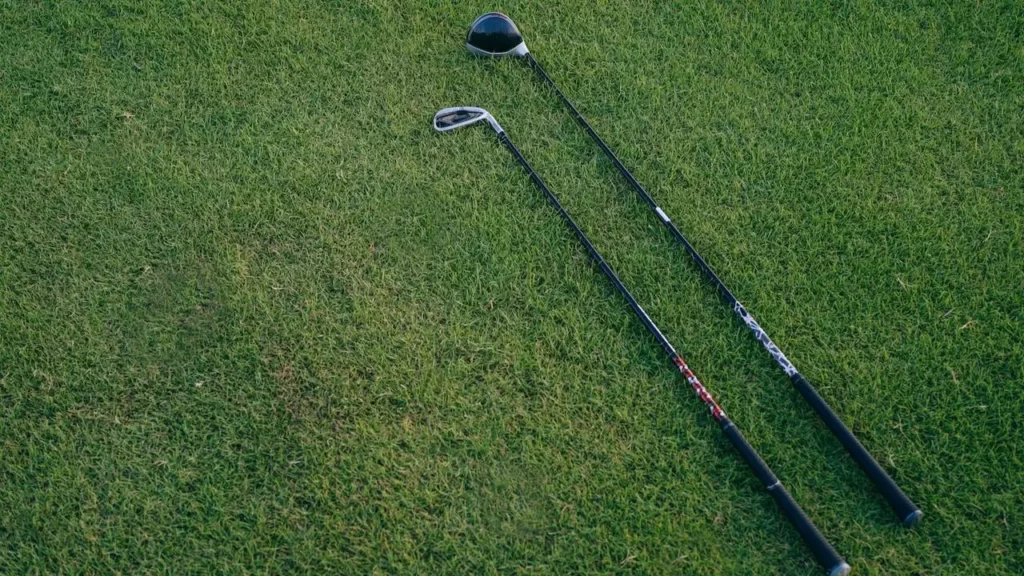
Enjoying this article? Read more:
Check out this video below from Gimme Golf‘s YouTube channel:
How to Maintain Your Golf Clubs on the Course
Maintaining your golf clubs on the course is an essential step to preserving their quality. If you truly care about your equipment, you need to take the necessary measures to ensure that it stays in top-notch condition during each round you play.
Firstly, it’s essential to keep your clubs clean throughout the game. A few quick wipes with a towel after every shot will prevent dirt and grass from accumulating on them. This simple act goes a long way toward preserving the quality of your club heads and shafts.
Secondly, make sure that you’re using the right club for each shot. The reason for this is simple: using the wrong club can cause damage to both the club and the ball. Using your fairway woods for tight lies could lead to them getting scratched or dented, while hitting drivers off of hard ground could cause damage to both your driver and the ball.
Another crucial factor in keeping your clubs on course is ensuring that they’re not exposed to rust. Rust can quickly accumulate on metal clubs if they’re left damp or wet for extended periods. To avoid rust building up on club heads, use a towel or brush immediately after hitting any shots in wet conditions.
Put away any wooden clubs before it starts raining heavily or if there’s a risk of lightning strikes. Moisture can seep into wooden clubs’ pores over time, causing them to swell and crack over time.
Taking good care of our golf equipment is as important as improving our golf swing itself, which also requires time at home practicing with our home golf simulators, so don’t overlook it!
With proper cleaning techniques and maintenance practices like those outlined above, we can ensure that we get many more enjoyable rounds out of our prized possessions without having to spend more money replacing them because of neglectful behavior toward their upkeep!
Enjoying this article? Read more:
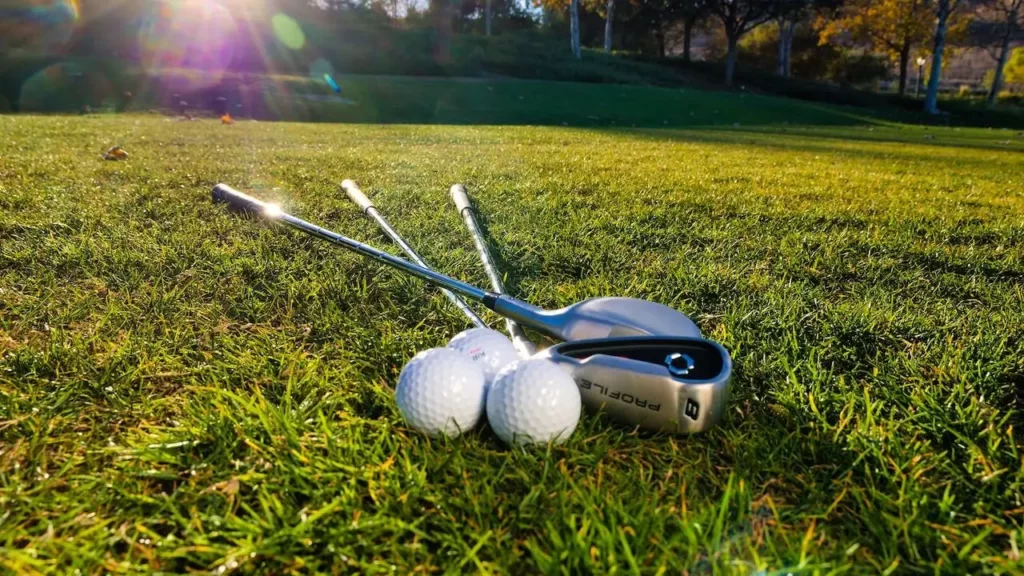
Storing and Caring for Your Golf Clubs
Now that you have learned how to clean golf clubs properly, it’s important to know how to store and care for them. After all, you’ve spent a lot of money on your golf clubs, so why not protect your investment?
Here are some tips on storing and caring for your golf clubs.
Firstly, it’s important to keep your golf clubs organized. Whether you’re storing them at home or in the trunk of your car, they should be stored in a way that minimizes damage. A great way to organize your golf clubs is by using a golf bag. Make sure the bag is appropriate for the size of your clubs and the number of accessories you have. It’s important not to overcrowd the bag, as this can cause unnecessary wear and tear.
When cleaning fairway woods or any other wooden club, it’s essential to preserve their quality by storing them in a climate-controlled environment. Extreme temperatures can warp wooden shafts over time, leading to lost accuracy on the course.
Another thing you should do is remove dirt from the shaft before storing it away between rounds. This will prevent dirt from building up and potentially causing damage over time.
If possible, avoid leaving your golf clubs in direct sunlight or exposing them to extreme temperatures, as they can cause discoloration or even cracking in certain materials, like plastic grips. If left unattended longer than necessary (like overnight), they may rust due to moisture buildup caused by dew on the grass during early morning rounds if not dried thoroughly after use.
When purchasing new clubs, make sure they meet all of your specifications so that they don’t require excessive maintenance while also ensuring better ball striking through additional weight distribution options that fit your personal preference best!
Remember: club maintenance prolongs life expectancy, which means fewer expenses for replacing equipment over time, so invest wisely today!
Check out this video below from Golf Monthly‘s YouTube channel:
Enjoying this article? Read more:

Conclusion
Cleaning your golf clubs is an essential part of maintaining their optimal performance and lifespan.
Whether you’re an amateur or a professional golfer, taking good care of your clubs should be a top priority if you want to improve your game over time. By following the steps outlined in this article, you’ll be able to keep your golf clubs in pristine condition and prevent rust buildup that can negatively affect their performance.
Additionally, regular club maintenance will make them look like new for longer periods of time, which can make a significant difference in how you feel about them. Maintaining your golf club grips is especially crucial since they are the only point of contact between your hands and the club.
As such, it is essential to clean them regularly with soap and water or other cleaning products specifically designed for grip care. A clean grip ensures that you maintain a secure hold on the club throughout your swing, which ultimately improves accuracy and consistency.
While proper cleaning techniques are important, don’t forget about other aspects of club care, such as storing them properly and having regular checkups for rust spot removal. These small details can make all the difference in how well your clubs perform on the course.
Incorporating these golf accessory care techniques into your regular routine will help keep rust at bay and ensure that your metal woods, irons, or wooden clubs last longer while still looking great on the course. With proper club maintenance techniques under control, including cleaning putters or drivers, you’ll have more time to focus on improving that golf swing!
So don’t forget to take good care of those grips—they’re just as important as any other part of the club when it comes to playing great golf! And if all else fails or if you need an extra hand carrying all those clubs around during practice rounds, then consider hiring a helpful golf bag assistant or investing in a caddy for some friendly moral support while out there hitting those drives.
Share this Post
Toni Benedito
Keep Reading
Follow Us
Recent Posts

How Do Pro Golfers Get Paid? The Business of Golf
Professional golfers get paid both before and after tournaments. Before a tournament, they receive appearance fees, sometimes exceeding $1 million, to attract top players. After the tournament, earnings depend on their placement, with the PGA

How Much Do Golf Players And Pros Make? You Won’t Believe It!
Professional golfers earn substantial incomes through tournament winnings, sponsorship deals, and endorsements. Top players on the PGA Tour can make millions annually, with significant earnings from prize money and lucrative brand partnerships. For example, Rory

The Shocking Cost: How Much Does It Cost to Fly with Golf Clubs?
Flying with golf clubs can be a hassle, but it’s worth it for avid golfers. Costs vary by airline, ranging from $30 to $150 per way. Southwest Airlines offers a generous policy, allowing one set

Why Do Golfers Tape Their Fingers Before Hitting the Course?
Golfers tape their fingers to prevent injuries from repetitive motions, provide support for existing injuries, and improve grip comfort. It’s a popular technique among amateurs and pros alike, offering a lightweight and effective solution compared

How Much Does a Round of Golf Cost? Are You on Par?
The cost of a round of golf varies widely based on factors like course type, location, and time of play. Public courses typically range from $30-$100 per round, while exclusive ones like Augusta National or

Hidden Fees: How Much Does It Cost To Rent a Golf Cart
Wondering how much it costs to rent a golf cart? Explore factors like location, rental duration, and cart type impacting prices. Daily rates range from $50 to $80, while weekly rentals can vary from $200
Table of Contents







